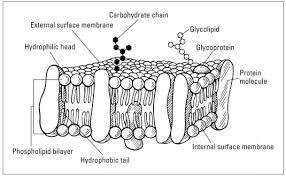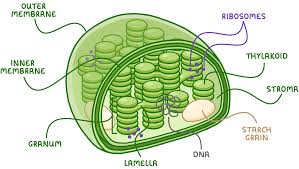Unit 6: A Tour of the Cell
warm-up 3/5: How are plant and animal cells different? Same?
animal cells: lysosomes, centrioles, flagella
both: vacuoles, nucleus, ribosomes, mitochondria, ER, golgi, nucleolus
plant cells: large central vacuole, chloroplasts, cell walls, clorophil
2 types of cells:
Prokaryotes: Domain Bacteria and Archaea (Biggest distinguishing factor: No nucleus)
Eukaryotes (domain Eukarya): protists, fungi, plants, animals
A prokaryotic cell (bacteria)
Prokaryote
“before” “kernel”
no nucleus
DNA in a nucleoid
cytosol/cytoplasm
no organelles other than ribosomes
small size
primitive
bacteria and archaea
1-10 um
Eukaryote
“true” “kernel”
nucleus/nuclear envelope
cytosol/cytoplasm
membrane-bound organelles with specialized structure/function
much larger in size
more complex
plant, animal, protist, fungi
10-100 um
Nucleus
function: control center of cell that contains DNA
surrounded by double membrane (nuclear envelope)
continuous with the rough ER
Nuclear pores: control what enters/leaves nucleus
chromatin: made of DNA + proteins; makes up chromosomes
nucleolus: region where ribosomal subunits are formed
Warm up
A. Nucleolus- RNA synthesized here, produces ribosomes
B. Nuclear pore- areas where ribosomes are released
C. Nuclear envelope- double emmebrane that surrounds and protects nucleus
D. Chromatin- genetic material before it condenses into chromosomes
E. DNA- genetic material
F. RNA- protein synthesis
G. Chromosome- structures that carry genetic info
H. Genes- found on chromosomes, give us traits + characteristics,
Warm up 3/7: the functions of these parts
Nucleus- contains the genes, brian of the cells
ribosomes-protein synthesis
Golgi- packages, transports, sorting
smooth er- lipid synthesis, modifies lipids
rough er- protein synthesis/modification
vesicle- membrane sacs that contain nutrients, golgi apparatus
Chloroplast- site of photosynthesis
Mitochondrion- powerhouse of the cell where energy is made, cellular respiration
cytoplasm- what holds organelles in a cell, metabolic activities
plasma membrane- selective barrier that lets things in and out of cell
pili- help attach bacteria
cilia- tiny hairs that help remove foreign stuff
microvilli- cell receptors, hairlike, in digestive system, increase surface area so we can absorb nutrients
nucleolus- makes ribosomes, in nucleus
plasmid- horizontal gene transfer
central vacuole- plays a role in plant cell growth, contain water, waste, structure
lysosomes- used for digestion and remove waste, recycling units, found in immune system, white blood cells contain lots of
chromatin- makes up chromosomes
MRSA- Methicillin-resistant staphylococcus aureus
ribosomes
function: (translation) protein synthesis and made of rRNA + proteins
large subunit + small subunit
types:
1. free ribosomes: float in cytosol, produce proteins used within cells
2. bound ribosomes: attached to ER, make proteins for export from cell
Endomembrane system:
regulates lipid and protein modification, packaging, and transport
performs metabolism functions (chemical reactions)
Includes: endoplasmic reticulum, golgi apparatus, vesicles, lysosomes, cell membrane and nuclear envelope
Endoplasmic reticulum (ER) (Biosynthetic factory)
network of membrane and sacs
types:
Rough ER: ribosomes on surface
function: transport and package proteins for secretion, send transport vesicles to Golgi, make membranes
Smooth ER: no ribosomes on surface
function: synthesize lipids, metabolize carbs, detox drugs and poisons and in muscles, they store Ca2+
Golgi Apparatus
functions: synthesis and packaging of materials (small molecules) for transport (in vesicles); produce lysosomes and package lipids and proteins into vesicles
series of flattened membrane sacs (vesicles)
cis face: receives vesicles
trans face: ships vesicles
Warm-up 3/10/25:
What are the functions of the endomembrane system? What organelles are included?
Regulates lipid and protein modification, packages, and transports.
1. endoplasmic reticulum 2. golgi apparatus 3. vesicles 4. Lysosomes 5. cell membrane 6. nuclear envelope
Lysosomes (only found in animal cells)
Originate in the Golgi Apparatus.
Function: intracellular digestion of macromolecules and pathogens; recycle cell’s materials; performs programmed cell death when necessary (Apoptosis).
Contain hydrolytic enzymes (Break down).
Prefer an acidic environment (low pH).
Found a lot in white blood cells.
Vacuoles
Function: storage of materials, (food, water, minerals, pigments, poisons)
Membrane-bound vesicles
Ex. food vacuoles (formed by phagocytosis ), contractile vacuoles (regulates water pressure)
Plants: Large central vacuole -- stores water, wastes and gives cells shape.
Mitochondria (be able to draw and label)
Function: site of cellular respiration.
Double membrane: outer and inner membrane.
Cristae: folds of inner membrane for increased surface area: contains enzymes for ATP production.
Matrix: fluid-filled inner compartment.
Continued--
Mitochondrial DNA: Same as our Mamas
Cellular Respiration= REDOX reactions transfer electrons from (glucose) by breaking the bonds which makes ATP, the energy controlling all biological processes.
Oxidation= electron loss Reduction= electron gain
C6H12O6 + 6O2 →6CO2 + 6H2O + chemical energy 32_ - 36 (ATP)
Locations:
Glycolysis- in cytoplasm
Krebs Cycle - Matrix
Electron Transport Chain - Cristae
Warm up 3/11: Explain how proteins are manufactured in the cell and sent out and used in the body
and onto the rough ER. In the rough ER protein is synthesized and then through the golgi apparatus, they are sent out to the body for usage for structure, growth
start in the nucleolus which produces ribosomes that are sent out of the nuclear pores
rough er transports and modifies the amino acids and are sent to the
golgi apparatus where they are package, modified, and placed into vesicles
The vesicles are then sent to the plasma membrane and dispersed through exocytosis and used by the body
Chloroplasts
double-membraned and site of photosynthesis
thylakoid disks in stacks of grana-light dependent reactons; contain chlorophyll (pigments) for capturing light energy to form ATP and NADPH (enzyme)
stroma (fluid)- Calvin cycle or dark reactions- carbon fixation is used to “fix” into organic molecules glucose (the food for the autotroph)
Endosymbiont theory (symbiogenesis)
Mitochondria and chloroplasts share a similar origin
Prokaryotic cells engulfed by ancestors of eukaryotic cells
evidence:
double membrane structure
have their own ribosomes and DNA
reproduce independently within cell
want as many mitochondria as possible which means more cellular respiration, which means more energy
Peroxisomes (liver and kidney)
functions: contain various enzymes that break down fatty acids (lipid biosynthesis); detox alcohol (catalase) as well as alcohol dehydrogenase; prevent kidney stones
involves the production of hydrogen peroxide (H202)
Cytoskeleton: network of protein fibers
Function: support/structure, mobility, regular biochemical activities
3 types: microtubules, microfilaments, intermediate filaments
Warm up 3/12:

carbohydrate- recenptors to identify cells and pathogens
phospholipids- hydrophilic heads hydrophobic tails
cholesterol- prevents tails from sticking together and keeps fluidity of membrane
integral protein- takes up the entire membrane and has channels that pass through substances
peripheral protein-
channel protein- area where substances more into and out of the cell
fluid mosaic model- because it must be flexible and fluid, It is called mosaic because of that intricate parts
Extracellular Matrix (ECM)
outside plasma membrane
composed of glycoproteins (ex. collagen and antibodies )
function: strengthens tissues and transmits external signals to cell
Plant cells
cell wall: protect plant, maintain shape
composed of cellulose and lignin
plasmodesmata: channels between cells to allow passage of molecules and cellular communication (play a role in fighting off pathogens like fungal, bacteria, viral)
Surface area example (plant):
root hairs: extensions of root epidermal cells; increase surface area for absorbing water and minerals. enables the transport water to the xylem vessels
nutrients: phloem
Surface area example (animal):
small intestine: highly folded surface increases absorptions of nutrients
villi: finger-like projections on small intestine wall that allow for nutrient absorption
microvilli: smaller projections on each (found in large intestine too)
Plant cells only | Animal cells only |
central vacuoles | lysosomes |
chloroplasts | centrioles |
cell wall of cellulose | flagella, cilia |
plasmodesmata | desmosomes, tight and gap junctions |
extracellular matrix (ECM) |
warm up 3/13: draw a chloroplast- label lamellae, stroma, grana, thylakoid, DNA, ribosomes, double-membrane. Where do light reactions occur? and Why? Where do dark reactions occur?

Light reactions occur in the thylakoid to capture light energy and turn it into chemical energy as the form of ATP and NADPH
Dark reactions occur in the stroma, and these occur by using the two energy molecules to make (chemical to chemical) CO2 into glucose. perform carbon fixation to make glucose
Chapter 7
Cell membrane (fluid mosaic model)
A. plasma membrane is selectively permeable
B. fluid mosaic model
fluidity: membrane held together by weak interactions and keeps the flexibility
mosaic: phospholipids, proteins, carbs, cholesterol
phospholipids
bilayer
amphipathic = *hydrophilic head* hydrophobic tail
hydrophobic barrier: keeps unwanted materials out like wastes and pathogens
Membrane proteins
intergrall proteins | peripheral proteins |
embedded in membrane | extracellular sides of membrane not embedded |
have channels to allow substances to pass through | held in place by the cytoskeleton or ECM |
can help signal to other cells to transport materials across the membrane | Can act as receptors or enzymes C |
Carbohydrates
function: cell-cell recognition or signaling; cell attachment; regulation of immune system
glycolipids and glycoproteins
ex. blood transfusions, type-specific- A, B, AB, O
Passive Transport
NO ENERGY ( ATP ) needed!
Diffusion down concentration gradient (high →low concentration)
it is controlled by a) temperature b) pressure and c) concentration
small nonpolar molecules like hydrocarbons ( fuels ), CO2, O2, H2O
Facilitated Diffusion
transport proteins (channel or carrier proteins) help hydrophilic substances cross
two ways:
provide hydrophilic channels
loosely bind/carry molecule across one at a time
ex. ions, polar molecules ( H2O, glucose)
Types of Facilitated DIffusion:
glucose transport protein: (carrier protein) carries glucose into blood and levels are controlled by the hormone insulin released by the pancreas
aquaporin: (channel protein) allows passage of H2O (ex: kidneys)
Active Transport | Passive Transport |
Requires Energy (ATP) Electrogenic pumps & Larger, polar molecules | No Energy Needed (ATP) Diffusion, facilitated diffusion, osmosis Small, nonpolar molecules |
Active Transport
Requires Energy (ATP)
Proteins transport substances against the concentration gradient (low →high conc.)
Ex: Na+ / K+ pump, proton pump, Endocytosis/Exocytosis
Electrogenic Pump
: generate voltage across the membrane
Na+/K+ Pump 3 sodium ions going out 2 potassium going in | Proton Pump |
Pump Na+ out, K+ into cell | Push protons (H+) across membrane |
nerve transmission and muscle contraction | Ex. mitochondria (ATP production) |
3 sodium ions going out 2 potassium going in |
|
ATPase |
Bulk Transport
: Transport of proteins, polysaccharides, and other large molecules.
Endocytosis- takes in macromolecules and particulate matter, and forms new vesicles from plasma membranes. Ex; carbs, lipids (cholesterol), proteins, pathogens by white blood cells
Exocytosis; vesicles fuse with the plasma membrane, and secrete contents out of the cell (proteins and lipids). Ex: Pancreas- insulin & Brain- neurotransmitters
Types of Endocytosis
Phagocytosis:
“Cellular eating” - solids
Ex: WBC devouring pathogens
Pinocytosis:
“Cellular drinking” - fluids
Ex: microvilli in SI absorbing nutrients
Receptor-Mediated Endocytosis (RME) :
Ex: Specific receptors on cell surface indicate what to engulf, cells can absorb hormones, cholesterol, pathogens and nutrients
Warm-up March 08 2025
Draw A mitochondria. Label cristae, matrix, glycolysis, electron transport chain, krebs cycle, dna, ribosomes, double membrane.
Write out chemical equations for cellular respiration.
C6H12O6 + 6O2 → 6CO2 + 6H2O + Energy (ATP)
Osmoregulation (passive)
Control salt & water balance in the body
Contractile Vacuole: in protists, it is a “bilge pump” that forces out H2O as it enters by osmosis.
Ex. Paramecium (protist)-contractile vacuole, fresh and saltwater fish - gills, humans- kidney
External environments can be hypotonic, isotonic, or hypertonic to internal environments of cell
Warm up 3/19: what happens to RBC’s (red blood cells) and plant cells in the following solutions → hypotonic (C6H12O6) hypertonic (salt water) isotonic
erythrocytes (red blood cells)→ Hemolysis (cells expand then burst) Plasmolysis (cell shrivels) Equilibrium
plant cells → Turgid, Plasmolysis, Flaccid
Video notes
Osmoregulation
fish in the ocean are hypotonic compared to the water in its environment
cytolysis- bursting of cells
why is it that we can not drink ocean water? bc our body is trying to get rid of salt being injected and this happens with our kidneys, this releases water in our body and we become dehydrated